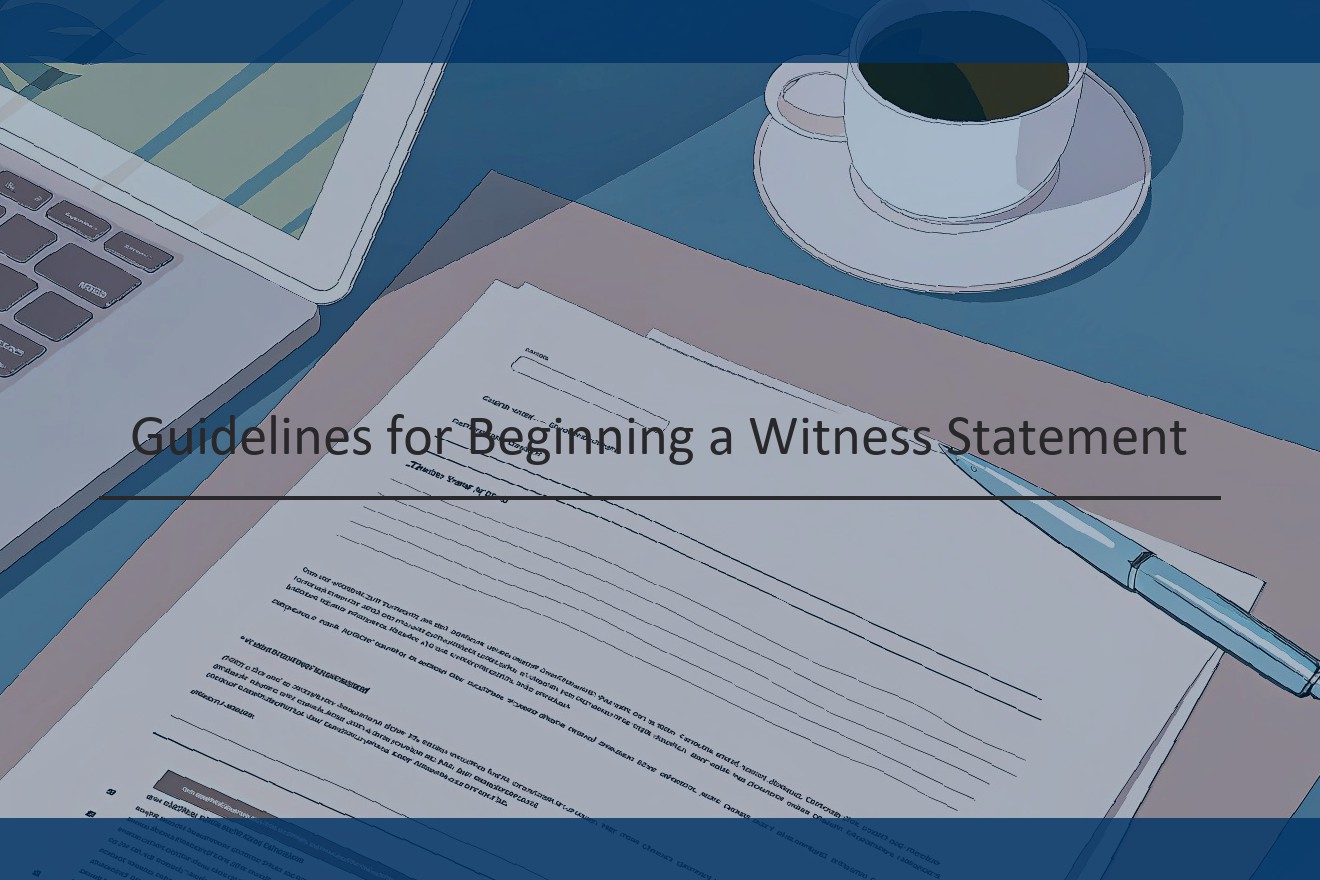The Importance of a Witness Statement
Witness statements are a fundamental part of civil litigation, both before trial and at the hearing itself. A witness statement is a written account of facts as seen or heard by a litigant. It is a way of providing evidence to a judge on an issue. So a party may produce a witness statement from a friend , business associate or even the litigant themself.
Witness statements will be produced in support of a defence or claim. They will detail matters that need to be proved and will be used in determining whether the case is to be won or lost. Mistakes in the wording, structure and presentation of statements can lead to significant costs and time being wasted when the judgment is appealed.
For all these reasons it is important we grasp the basics of preparing a witness statement.
Main Components of a Witness Statement
A witness statement should be accurate, concise and to the point. A typical witness statement will set out facts in chronological order. If a witness can clearly remember specific relevant times, times can be stated. A witness can also refer, in brackets afterwards, to pictures or other documentary evidence which are also attached to the statement. A witness statement must include a declaration of truth to the following effect: "For the purposes of the hearing(s) commencing on [insert date of hearing], I believe the facts in this statement to be true and accurate to the best of my knowledge and belief. I have neither received nor paid any money or other benefit of any kind in consideration or exchange for making this statement." If a witness is unsure of the facts they are being asked to state, then this should be made clear in the statement.
How to Prepare for Drafting Your Statement
While it may be tempting to just sit down and write out all you can remember about your case, there’s a few steps you need to take first to ensure that the witness statement you produce is as good as it can be. The aim of the statement is to adequately inform the court of your evidence, including any background information that places your evidence in context.
So before you begin writing the statement, you must:
Recruit any relevant documents – if you have a contract, emails, photographs, or any other documents that relate to the events you’re writing about, make sure they’re easy to access before you start writing.
Check for any legal guidelines – a witness statement needs to adhere to strict legal requirements. For example, it will need to be signed by the person providing the evidence and contain a signed statement of truth. Familiarise yourself with the legal requirements for your area before you start writing.
Look through your case file – the last thing you want is to get half way through writing your statement and forget an important detail. To prevent this, read through the case file as you prepare to write the statement and make a note of anything you want to ensure you include.
How to Write an Introduction
A very important part of the statement is the introduction. Essentially, you don’t want the Judge or Tribunal Panel to have to read too long a statement before they can start to understand the case. Clearly, if it can be done in two or three short sentences then that is ideal, but it is important to get it right.
Basically, the format follows a simple structure. Introduce who the witness is e.g., "I, Mr X, of the above address, am the Petitioner’s father. On 1 January 2013 I saw the Respondent For a drink at the Red Lion Pub in Somerset." Then highlight the points of contention that need to be addressed so the Judge or Tribunal Panel have an idea of where the statement is going e.g., "I found this very strange as my daughter had only seen her doctor the week before and had been given lots of medication."
It is also useful for the introduction to identify what the evidence actually is so that any factual information given can be put into context e.g., "I am aware from personal experience that the drug that my daughter has been prescribed has been known to cause people to become aggressive."
Whatever way you choose to do the introduction, it is important that you begin with something strong and convincing. In this case, it isn’t about style and flair, it is more about keeping a clear line of reasoning that is easy to follow.
Using Simple and Exact Language
A large part of the skill required for writing a good witness statement is the ability to express yourself in terms that are clear and unambiguous – both for the benefit of the reader and for the benefit of the court. The rule is quite simply to say what you mean and mean what you say with no embellishment, no waffle and definitely no fancy words. Clarity and conciseness are vital attributes in witness statement writing – anything else just adds unnecessary verbiage that detracts from the focus of the statement itself and creates confusion. It goes without saying that correct grammatical usage is also critically important and must be observed throughout the statement. A failure to do so will almost always lead to the statement being regarded as unreliable.
It is equally vital that the statement gives an accurate account of events , with a clear chronology, so that it can be followed easily by the reader. At the same time, you must always complete your statement in accordance with the lawyer’s instructions and the lawyer will usually have adopted a particular structure that he/she requires to be followed. Therefore, where the lawyer has instructed on a specific format you should be careful to adhere closely to this.
Pitfalls to Avoid
Common errors when starting a witness statement include trying to write it in your own words, or making the statement too detailed. Firstly, a good witness statement is not a narration of the events, nor is it a first recollection of those events. It is the beginning of a longer process because unless the dispute goes to trial, it will probably be the only opportunity you will get to put down your recollection of events on paper. It is likely that the opposing party will always put forward their own version of events, and if you do not stick to your version when giving your evidence in court, or when you give further instructions to your solicitor about your recollection of events, you will be undermined and your evidence will not be credible. This is why it is so important that you ring-fence what you have said in your witness statement.
Secondly, the witness statement should not be too detailed. Quite often an account of the events on which you are giving evidence can be very long and very complicated. There may be documents, telephone calls and conversations that only you know about. If all of these are included in the witness statement, it may actually put your evidence on the back foot. If there are lots of unrelated details, the person reading the statement may not be able to identify the crux of the matter and may also lose interest. If there is too much detail, the reader will then potentially pick up on some of the less important details. Having too much detail opens a can of worms, and means that those details become part of your evidence. If you cannot distinguish between important and less important detail, and you try to second-guess what detail is imperative to the case and what detail may be better omitted, it is likely that the reader will identify the information they consider important and that you consider irrelevant. From this, you can see just how easily misunderstandings can occur and how damaging this can be to your case.
The trick here is to start with a broad brush outline of what the incident was that you are giving evidence about and what part you played. It is a good idea to get something down on paper before you forget any important detail. Then revisit this when you have found relevant supporting documentation or indeed, when someone else from the same company gives a different version of what happened. In this way you will know the background to the incident. You can then pick out significant details that will help you to give your own version of events.
Revising and Finalizing the Statement
Once you have completed the draft, read through the entire statement, several times, to ensure that you as the witness are comfortable with it. You should read the statement with a view that you will be asked to sign it under oath so it must be accurate.
Read it for style. Is it easy to understand? Sometimes a lay reader will find things that should be explained in more detail or made simpler to follow. Take the time to make these revisions.
Check for accuracy of all statements . Are the times, dates, calculations and names correct? Are all proper names spelled accurately? Make sure there are no spelling errors. Does the statement look professional and appropriate for submission to the Court? The negotiability of a witness’ statement is often judged on its appearance.
Finally, check for correctness of form. Is the statement in first person or third person? In the first person, the witness refers to himself or herself such as "I am…". There should not be any use of "we" in the statement unless the fact you are describing involves multiple people.




+ There are no comments
Add yours